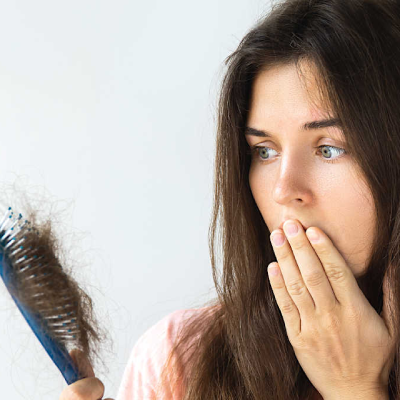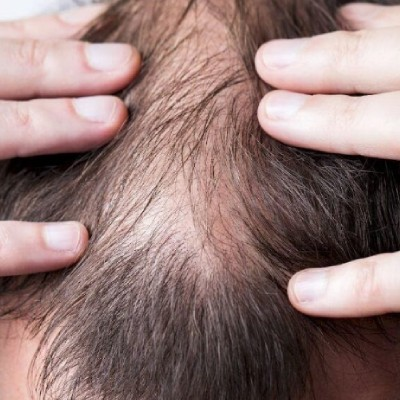Signs of Early Hair Loss and How to Stop It

16 March 2022

Hair Experts @ AHS

It is possible to have alopecia (hair loss) that affects just your scalp or your whole body. Men are more likely than women to lose hair on their heads. Medical disorders, hormonal changes, or age may all have a role in the development of wrinkles.
It is possible to have alopecia (hair loss) that affects just your scalp or your whole body. Men are more likely than women to lose hair on their heads. Medical disorders, hormonal changes, or age may all have a role in the development of wrinkles.
Hair loss from the scalp is the most common cause of baldness. A family history of hair loss is the most prevalent cause of thinning hair as people become older. Some individuals would rather let their baldness go unchecked and unattended. Hairstyles, cosmetics, hats, and scarves may be used to hide them. On the other hand, others opt for one of the many therapies available to halt or reverse hair loss.
Early Signs of Hair Loss
Some of the early signs of hair loss include:
1. Gradual Thinning
The top of the skull begins to thin out over time. As individuals become older, they are more likely to have this sort of hair loss. Men's hairline frequently starts to recede at the hairline on the forehead. Women's hair tends to have a wider portion than men’s. A receding hairline is a hair loss trend that is becoming more frequent in older women (frontal fibrosing alopecia).
2. Bald Areas that are Round or Spotty
Circles of baldness may form on the scalp, the beard, or the eyebrows of certain individuals as they lose hair. Before the hair starts falling out, your skin may become inflamed or uncomfortable.
3. Sudden and Unexpected Hair Loss
A lot of hair might come out while combing, shampooing, or even if you just gently pull your hair. This form of hair loss creates thinning of the overall hair, although it is only temporary.
4. Full-body Hair Thinning
Several medical disorders and treatments, such as chemotherapy for cancer, may lead to hair loss on the whole body. Hair normally grows back in a healthy, normal pattern.
5. Scratches on the Scalp
Ringworm is the likely culprit here. Broken hair, redness, swelling, and, at times, leaking may accompany it.
6. Receding Hairline
It's normal for men to see their hairline receding as they get older, but you must pay attention to it if you detect early signs of a reclining hairline. A receding hairline worsens with time and finally spreads over the whole head, exposing the scalp in most instances. The sooner you realise that your hairline is receding, the quicker you need to see a hair loss expert.
7. Excess Hair in Your Brush or the Sink
It is typical to lose 50-100 hairs every day. If you see a sudden or excessive hair loss, it might be an indication that you have a health problem.
You should see your doctor if you see more hair in your brush or shower drain than normal. Early detection of the root cause of hair loss provides you with a better chance of reducing or halting additional thinning.
What is Causing Hair Loss?
Generally, hair loss is caused by several factors, including:
1. Alopecia Areata is Caused by Hormones
Androgenic alopecia-related hair loss occurs over time. Some individuals begin to lose their hair around the time of puberty, while others don't until their middle years.
Male pattern baldness is characterised by thinning at the crown of the head and above the temples, resulting in an "M" shape on the scalp. When women get male pattern baldness, the hair on their heads begins to thin down all over. It may also seem as though the area surrounding the component is becoming wider or thinner.
2. Acne
Hair follicles are attacked by your immune system in alopecia areata, resulting in bald patches that might be little or vast. It may lead to complete hair loss in rare circumstances.
Some persons with alopecia areata have hair loss on their scalp and brows, eyelashes, and other body regions.
3. Effluvium of Anagen
Hair falls out in a flurry in anagen effluvium. Radiation or chemotherapy is the most common culprit. After the therapy is over, the hair follicles are likely to regenerate.
An emotional or physical shock, such as a traumatic incident, a period of high stress or a significant sickness, may cause hair loss, which is known as telogen effluvium.
4. Capitis Tinea
Fungal infection Tinea capitis, often known as ringworm of the scalp, may damage the scalp and hair shaft. It creates itchy, scaly patches of baldness. These patches grow in size over time. In addition to these, there are some other symptoms:
- Fragile and easily broken hair
- Scalp discomfort and scaly areas of skin that seem grey or red
- Antifungal medications may alleviate the symptoms
5. Traction
Traction alopecia occurs when the hair is subjected to excessive pressure and tension, such as when it is braided, ponytailed or bunned. Scarring diseases like lichen planus and some kinds of lupus, for example, may cause lifelong hair loss as a consequence of the scarring. In addition, there are several other factors.
How Can You Keep Your Hair Healthy and Avoid Hair Loss?

You can enhance your general hair health and perhaps prevent hair loss by following a few simple hair care suggestions.
- Improve Your Hairstyle: There are a few things to keep in mind while avoiding hairstyles that cause hair to be pulled.Hair may be stretched to a certain point before it becomes irreversibly damaged. It is possible to lose the connection between your hair and scalp over time if you use cornrows, tight braids, or ponytails that strain your hair away from your scalp.
- Avoid Using Hair Styling Equipment that Generates a Lot of Heat: Hair follicles become dry and more susceptible to damage when heated. Straighteners, dryers, and curling irons may all harm your hair similarly.
- Don't Bleach or Chemically Alter Your Hair: Keratin, a protein found in hair, breaks down when hair is chemically treated with treatments like bleaching. Avoid using colors, highlights, peroxide treatments and perming if you're worried about hair loss.
- Use a Mild Shampoo: The shampoo is designed to remove debris and oil build-up from your hair. Shampooing your hair too often might cause it to become dry and brittle. Fragile and frizzy hair has been related to sulphates and other substances.Although no particular shampoo components have been shown to cause hair loss, they may contribute to certain individuals' less than optimum hair health. Shampoo that is as near to being all-natural as possible may help if you find your hair has become dry or frizzy.
- Use a Natural Fibre Brush: Using a gentle brush with natural fibres will help keep your hair's oil levels in check. If you brush your hair in one direction, beginning at the top and working your way to the ends, you'll be able to smooth and condition your hair cuticle. Hair clumps in the shower drain may be avoided by brushing your hair every day.
- Try Light Therapy at a Modest Level: Cell growth and healing are boosted by low-level light treatment. It can be a successful therapy for men and women who suffer from the most frequent type of hair loss, male and female pattern baldness. Hair loss occurs in a certain pattern as a result of these inherited diseases. At the top of the head, males begin to see receding hairlines or bald spots. In women, this is shown as a loss of hair and skin thickness, leading to an enlargement of the midriff.
Ways to Prevent Hair Fall During Pregnancy
As their bodies adapt to life after pregnancy, many women suffer from dehydration, exhaustion, stress and low oestrogen levels. Any of these conditions may exacerbate hair loss. Having a newborn may cause a lot of stress and weariness, leading to hair loss. Within a year after the end of the pregnancy, this issue is expected to go away.
If you're nursing, you should keep taking your prenatal vitamins, consume a balanced diet and avoid wearing your hair in tight styles that strain it away from your scalp to decrease hair loss after pregnancy. Until your hair loss slows down, dermatologists suggest using light shampoos and conditioners, as well as consulting a hairdresser, to make hair loss less noticeable.
How to Avoid Hair Loss when Undergoing Chemotherapy?
Your body's cancer cells are targeted by chemotherapy treatment. When you have chemotherapy, your hair follicles are damaged. In most cases, hair loss occurs after two to four weeks of therapy.
Before treatment begins, some patients prefer to shave their hair to prepare for this adverse effect. With this option, many individuals feel more at ease. Chemotherapy does not always result in complete baldness for everyone who receives it. Hair may thin or recede due to several reasons.
Ask your doctor whether scalp cooling treatments are an option for you. To keep your scalp cold, you'll need to wear a cooling hat throughout the treatment. Scalp cooling may help you maintain most of the hair, even if it isn't successful.
When Should You Consult a Doctor for Hair Loss?
Unexpected hair loss should be investigated by a medical practitioner for hair baldness treatment to establish the root cause and the most effective therapy. Be careful to bring up any other symptoms you've observed during your visit, such as:
- Exhaustion and a sudden drop in weight without any apparent cause
- Rashes on the scalp or torso, edema of the limbs, flu-like symptoms, such as constipation or diarrhoea
- Your family's history of baldness, as well as how rapidly the hair loss started, will also be beneficial
Conclusion
Hair loss affects a large percentage of the population; however, it is more prevalent among older people. In the majority of cases, hair loss may be attributed to heredity. Men and women with receding hairlines and bald patches on their crowns are both affected by hereditary hair loss.
A few hair loss treatments may help you halt hair loss and possibly restore some of your locks. An improved look can be achieved using a variety of methods, including the use of over-the-counter medications and natural home treatments for hair loss.
Stay Updated
Subscribe to our email newsletter for helpful tips and valuable resourses
Be an influencer
Join forces with Advanced Hair Studio! Explore exciting collaboration opportunities tailored for influencers. Let's redefine haircare together.
Connect now












